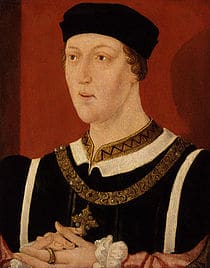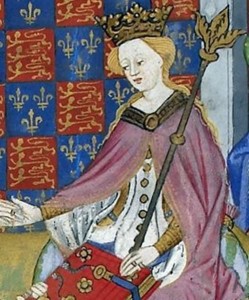 Today we have the final part of Nancy Smith’s series on ghosts who are said to haunt the Tower of London.
Today we have the final part of Nancy Smith’s series on ghosts who are said to haunt the Tower of London.
Monarchs Who Never Were – Hauntings at the Tower of London Part 4
by Nancy Smith
I will close with the story of Henry VI, one of England’s most tragic monarchs.
Henry’s story is somewhat outside of the scope of these articles as he actually reigned as king for nearly 40 years, from August 31, 1422 until March 4, 1461 and from October 30, 1470 until April 11, 1471. Whether or not he was rightfully king, however, depends on whether you supported the House of York or the House of Lancaster in the Wars of the Roses.
Henry VI’s grandfather, Henry, Duke of Lancaster (eldest son of Edward III’s third son, John of Gaunt) usurped the throne from Richard II, son of Edward III’s eldest son, Edward the Black Prince, in September 1399. Richard II died on February 14, 1400, while living in exile at Pontefract Castle, probably a victim of starvation. According to the rules of primogeniture, Richard II’s true heir was Richard, Duke of York, only son of Anne Mortimer, whose claim derived from her descent from Edward III’s second son, Lionel of Antwerp, Duke of Clarence. Those who believed that Henry VI was rightful king claimed that it was his descent through the direct male line via John of Gaunt who, as already mentioned, was Edward III’s third son.
Henry VI was the only son of Henry V and Catherine of Valois, daughter of Charles VI of France. He was born on December 6, 1421 and became king of England when he was less than 9 months old, on August 31, 1422, upon the death of his father. Henry was declared King of France two months later, on the death of his maternal grandfather, in accordance with the terms of the Treaty of Troyes, signed in the aftermath of the Battle of Agincourt, in which it was agreed that Henry V and his heirs would inherit the French throne upon the death of his father-in-law, Charles VI. As an infant, Henry VI was obviously too young to rule in his own right, so his paternal uncle, John, Duke of Bedford, was regent in France, while another paternal uncle, Humphrey, Duke of Gloucester, ruled England with the help of a council. In one of those strange coincidences that seem to happen in history, John, Duke of Bedford’s second wife was Jacquetta of Luxembourg who, by her second husband, Richard Woodville, 1st Earl Rivers, would become the mother of Elizabeth Woodville, who was to marry King Edward IV.
In 1437, five years before he reached legal majority, Henry lost his mother, Catherine of Valois, who died at Bermondsey Abbey in London shortly after giving birth to a premature daughter. A scandal ensued when it was discovered that Catherine had contracted a secret marriage with Owen Tudor, her Welsh clerk of the wardrobe, and had borne him several children. Henry VI created the elder two of his stepbrothers from this marriage, Edmund and Jasper Tudor, the Earls of Richmond and Pembroke, respectively. On November 1, 1455, 24 year old Edmund Tudor married 12 year old Margaret Beaufort, daughter of Henry VI’s paternal uncle John, 1st Duke of Bedford by his first wife, Margaret Beauchamp. On January 28, 1457 Edmund Tudor and Margaret Beaufort became the parents of their only child, Henry Tudor, who would become the founder of the Tudor dynasty. Henry’s claim to the throne was through his mother, a great-granddaughter of John of Gaunt and his third wife, Katherine Swynford. Despite the fact that Katherine Swynford had been John of Gaunt’s mistress for about 25 years before their marriage took place, and all of their children were born prior to their marriage, Richard II legitimized their children by Letters Patent in 1397. In 1407, Henry IV, John of Gaunt’s son by his first wife, Blanche of Lancaster, issued new Letters Patent confirming the legitimacy of his half-siblings while declaring them ineligible for the throne.

In 1442, when he was 20 years old, Henry VI reached legal majority. Unlike his warlike father, he was a gentle, devout and kindly monarch, much opposed to violence and obsessively devoted to religion. Due to Joan of Arc’s effort to free France from English rule, English interest in continuing the war with France declined, and a 2-year truce with France was concluded in 1443. In 1445, according to the terms of a peace agreement, Henry VI married Margaret of Anjou, a niece of Charles VII of France. Unlike her docile husband, Margaret was domineering and arrogant. She convinced Henry to cede many of England’s French holdings to Charles VII. This made her (and her husband) very unpopular, which led to the rise of Richard, Duke of York, who was believed to be Richard II’s true successor by many people in the first place.
Early in his reign Henry VI was said to be unsteadfast of wit, and in 1453, when he was 32 years old, he became seriously mentally ill. He entered into a trance-like state, reacting to and recognizing no one. Generally believed to be catatonic schizophrenia or depressive stupor, Henry probably inherited this from his maternal grandfather, Charles VI of France, who himself suffered from bouts of schizophrenia during the last 30 years of his life. Much to Margaret of Anjou’s chagrin, Richard, Duke of York was appointed protector in April 1454. Although Henry regained his sanity in January 1455 and was restored to the throne, he became ill again the next year, and Richard, Duke of York was once again named protector. With the king insane and unable to rule, two rival parties for power rose, one led by Queen Margaret and the other led by Richard, Duke of York. This was the origin of the long conflict known as the Wars of the Roses, with the House of York being represented by a white rose and the House of Lancaster being represented by a red rose.
Henry was taken prisoner at the Battle of Northampton on July 10, 1460, and on December 30, 1460 Richard, Duke of York was killed, along with his 17 year old son, Edmund, Earl of Rutland, at the Battle of Wakefield. Henry was rescued at the Second Battle of St. Albans on February 17, 1461. In early March the Duke of York’s eldest son, Edward, declared himself King Edward IV with the support of the City of London, while Henry VI fled, first hiding with the Scots and then on the Lancashire-Yorkshire border. He was finally captured in 1465 and imprisoned in the Tower of London for 5 years. Edward had obtained the throne with the support of the powerful Richard Neville, 16th Earl of Warwick (known as the “Kingmaker”), and the two fell out over foreign policy and Edward’s choice of a marriage partner. Warwick was negotiating with the French for Edward to marry Bona of Savoy, sister-in-law of King Louis XI of France, when Edward revealed in September of 1474 that he had secretly married Elizabeth Woodwille the previous May.
Warwick plotted with Edward’s brother, George, Duke of Clarence, possibly with the intention of installing Clarence on the throne in his brother’s stead. Warwick arranged to have his elder daughter, Isabel, married to the Duke of Clarence. However, when Warwick went into exile in France, seeking refuge with King Louis XI, Louis arranged a reconciliation between Warwick and Margaret of Anjou. One of the conditions of their agreement was that Warwick’s younger daughter, Anne Neville, was to marry Edward, Prince of Wales, son of Henry VI and Margaret of Anjou. The object of this alliance was to restore Henry VI to the throne. Warwick and Margaret’s forces landed at Dartmouth and Plymouth on September 13, 1470 and Edward IV, surrounded by the enemy, fled to the Netherlands on October 1. Henry VI was restored to the throne as a puppet king on October 30, 1470, and was paraded through the streets of London, a pathetic figure. The real power, of course, was in the hands of Margaret of Anjou and the Earl of Warwick.
On March 14, 1471 Edward IV, aided by an expeditionary force granted by Duke Charles of Burgundy, landed in Ravenspur in Yorkshire. Warwick was in the south, awaiting Queen Margaret and her son Edward, who were supposed to bring reinforcements from France but were delayed by bad weather. Warwick went in pursuit of Edward with the troops that he had, and on April 14 the two armies met at the Battle of Barnet. The Lancastrian army was defeated and Warwick was struck from his horse and killed while attempting to escape the field. On May 4, 1471, Edward IV defeated the forces of Queen Margaret and Prince Edward at the Battle of Tewkesbury, and the prince was killed either during or shortly after the battle. On May 21, Henry VI, who had been recommitted to the Tower, was murdered, allegedly while at prayer, in the Wakefield Tower. He was “stikk’d full of deadly holes” by a knife traditionally wielded by the Duke of Gloucester (later Richard III). While it is unlikely that the 19 year old Duke of Gloucester actually wielded the murder weapon, the murder of Henry VI was almost certainly ordered by Edward IV.
The body of Henry VI was displayed in St. Paul’s Cathedral as proof that he was dead, then buried at Chertsey Abbey with little ceremony. In 1485, after the accession of Henry Tudor as Henry VII, Henry VI’s remains were reburied at St. George’s Chapel, Windsor by order of the king. However, the spirit of Henry VI has never left the Wakefield Tower. As the clock ticks towards midnight on May 21, the anniversary of his murder, Henry’s sad ghost is said to appear in the Wakefield Tower, pacing fitfully around until the last stroke of midnight, at which time he fades slowly away to rest peacefully for another year.
Sources
Tower of London
- Tower of London – Wikipedia, the free encyclopedia
- Tower of London Ghosts & Legends
- The Ghosts of the Tower of London PT. 1
- Tower of London – Haunted Mansions Around the World
- Camelot International – Tower of London
- The Tower of London – Mysterious Britain and Ireland
- Ghost Stories – The Tower of London, UK
- Ghosts, Ghouls and Other Creatures!
- The Tower of London – The Tower’s Ghosts
- Britain’s Most Haunted Building – Richard Jones’s London Walking Tours
- Executions at the Tower of London – Richard Jones’s London Walking Tours
- Ghosts in the Bloody Tower – Richard Jones’s London Walking Tours
- Ghosts at the Tower of London – Richard Jones’s London Walking Tours
- Tower of London Ghost Stories
- Tower Ghosts – Tower of London – Icons of England
Henry VI
- Henry VI of England: Biography from Answers.com
- Henry VI of England – New World Encyclopedia
- Henry VI of England – Wikipedia, the free encyclopedia
- Henry VI, English Monarchs
- Richard Neville, 16th Earl of Warwick – Wikipedia, the free encyclopedia
- Richard II of England – Wikipedia, the free encyclopedia